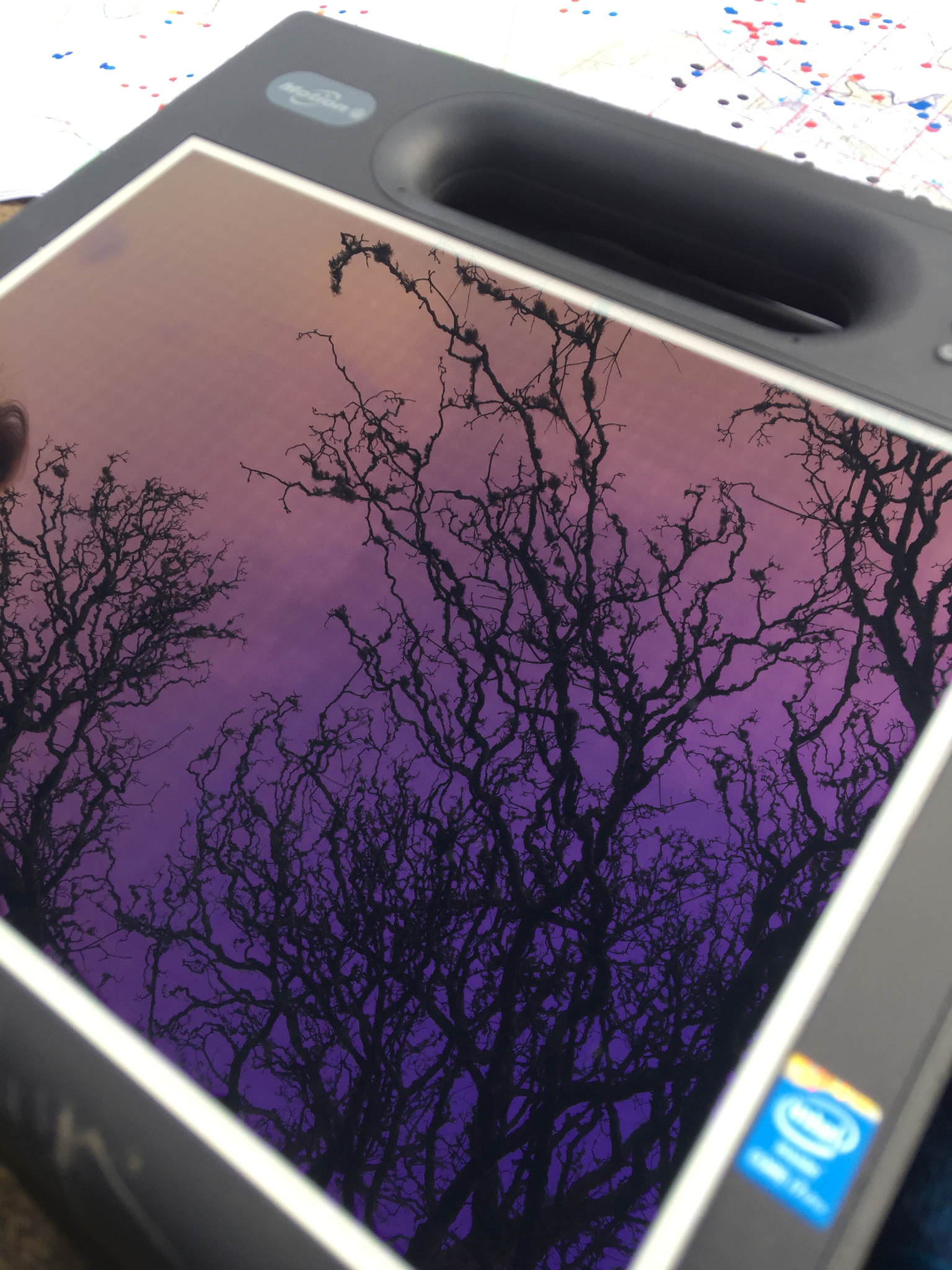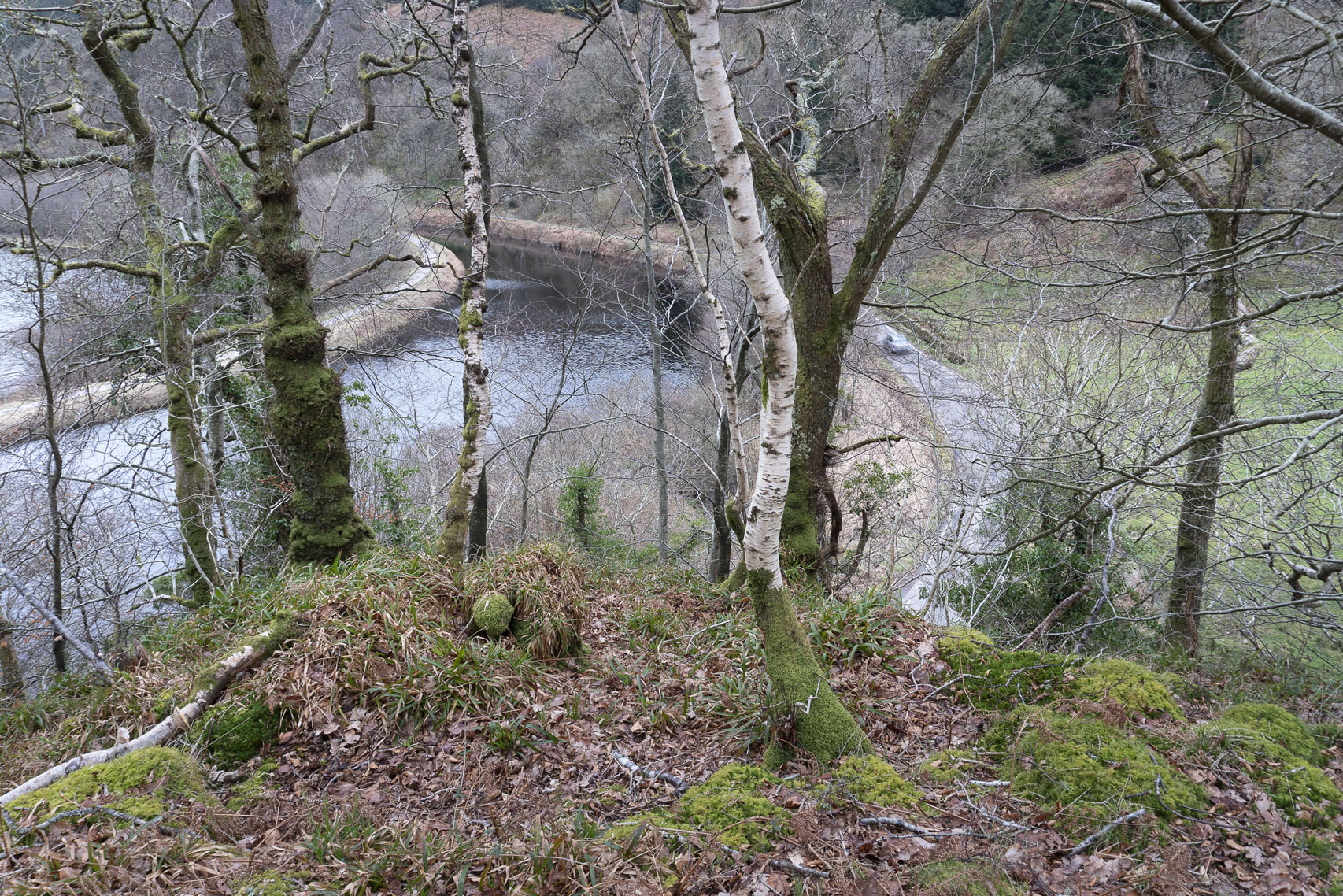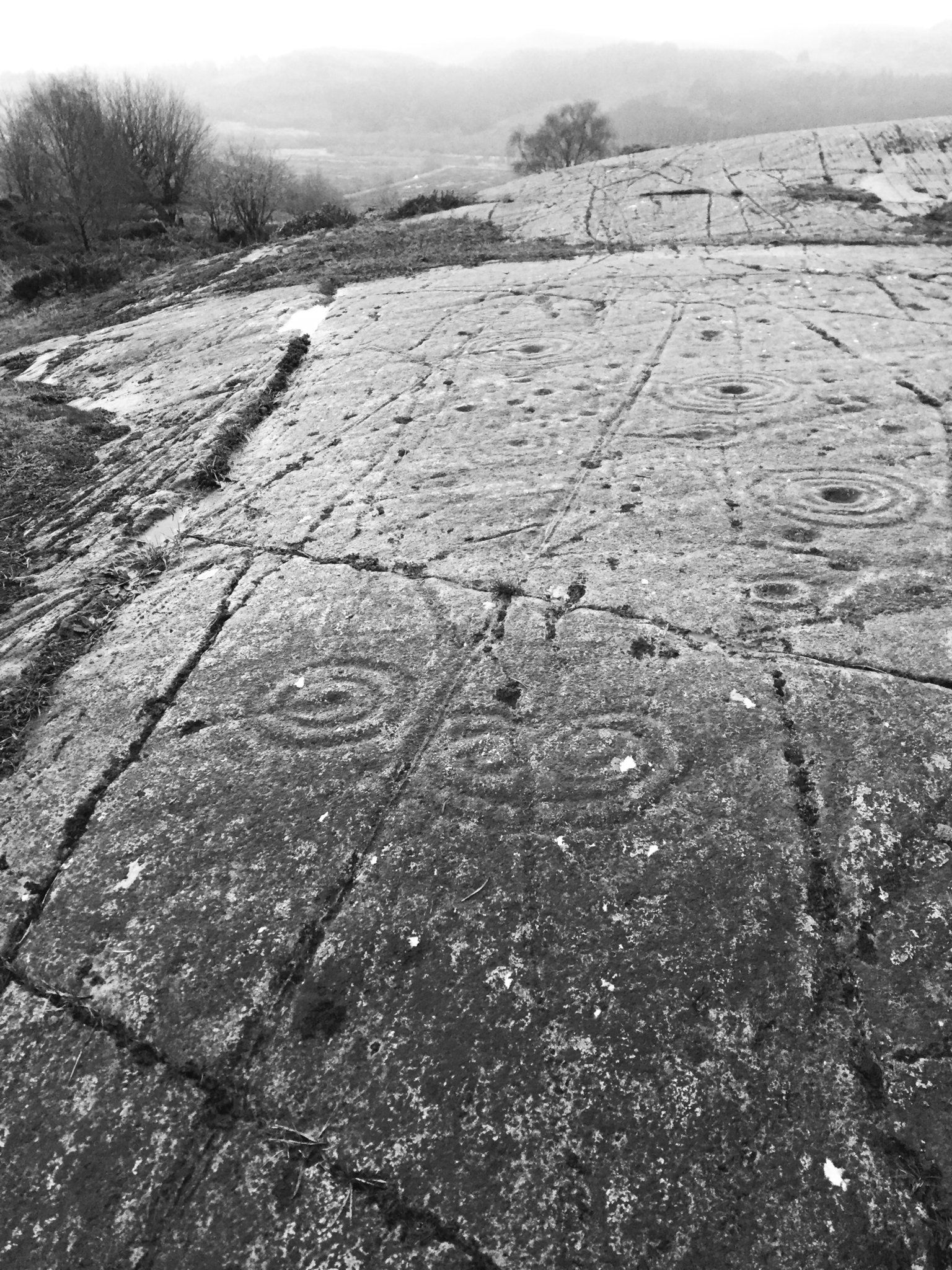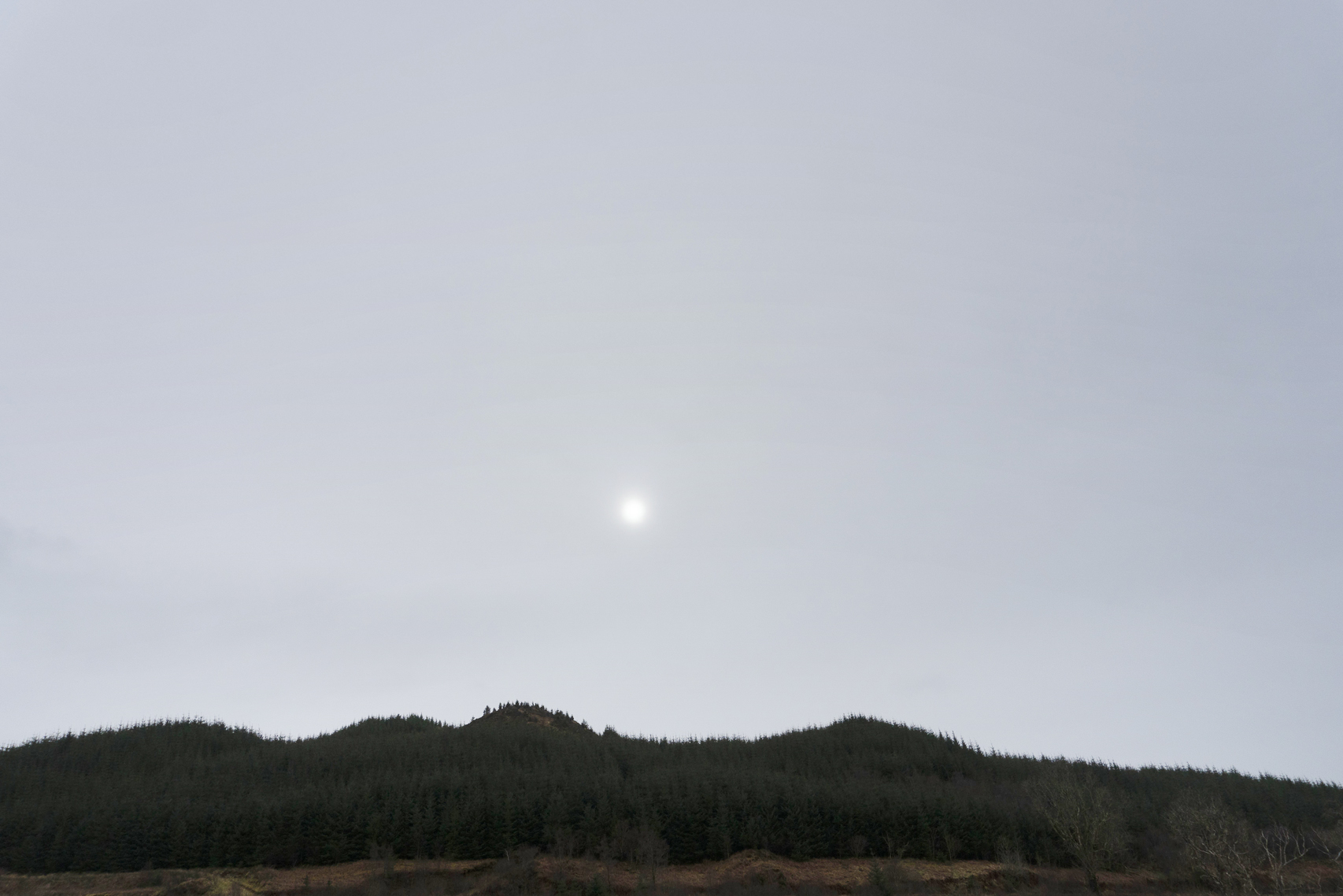Monday 11th March 2019
Lochgilphead and north to Kilmartin and the Museum – early spring lunchtime sun – we all gathered – Angela, Kat, Lukasz, Dave, Alex, Jim and Sam – consider the week ahead. Sunny and dry – today the view across the glen – eating together in the museum’s garden – views across the linear burial corridor – maps spread across the table – all-weather lap-top computers – their images of a grey landscape, stripped of all vegetation – a crop of target dots.
We are here to find more elusive archaeology than that directly before us at Kilmartin’s museum – things, sites, presences in the landscape that have become lost (or forgotten) with time, and later land use – things lost from memory – until LiDAR’s military technology has provided a means to scan the ground, to peel back the layers of vegetation, – the overgrowing – back to geology, and the persistent anomalous forms offering potential glimpses that hint at any subtle remains. Grey undulations on a portable computer screen, digitalized marks, smudges, hints and glyphs, pixels that might, or might not, cut through time (as the editing capacities of LiDAR can do) to evidence former dwellings and land usage that has become lost, obscured. Sites that have slipped beyond recall and, in effect, that have passed beyond ideas of place – both site and language. Those objective qualities that might be associated with the LiDAR system.
We (Alex and Jim) choose not to discuss, at this stage, our methodological approach to our specific research project - that will come later over the preceding months as we work and reflect on the coming days. At this stage, we agree it is better to ensure that our practice be a blind unfolding, which will lead us through LiDAR and language towards a creation of seeing, partial knowing and shared experience. This practice before methodological planning will, we hope ensure that real collaboration and mutual discovery will be present throughout the work.
Kilmartin Glen – southwards – Bridgend – circumscribing the expanse of Mòine Mhòr’s peat lands – spectres of early Celtic monks traversing this land – west following the Crinan canal – it is hard not to think of the 1953 film of the rusting Clyde puffer the ‘Maggie’, its rascally and picaresque-whisky fuelled crew, as they crossed this landscape in black and white – little changed but not the same – passed Bellanoch – south and east towards Tayvallich – possible targets off Bellanoch hill (Bàrr an Daimh) – a trapped landscape – ridges and gullies, of basalt rock and sediment filled gullies – steep climbs and sharp descents – a post-forested landscape, reseeding itself after some 15 years – tussocky grass – nothing found but stunning views down to the Canal and the River Add – out to Loch Crinan and the sea – back towards Crinan itself – just short of the end of the B841 – two possible dun sites.
Found a forestry track and an area of hillside that had been clear felled. Great views north-west, over the Crinan canal and the River Add out to sea. No sites located.
From the B841 we trudged up a beautiful linear quarry cut towards what turned out to be a non-existent dun site. A digital phantom. The next hilltop was cloaked by oak and birch, a thinly wooded knoll. The dun marked on Ordnance Survey maps proved to have traces of two and not one structure within its walls. This was added to the record. Woodrush covers the dun mount. Occasional quartz facing stones, a gentle white in the wooded gloom.
Back at road level a natural fissure – almost a cave – light from a mobile phone to check details, if any, in the shadows.
Tuesday 12th March
Atlantic woodlands – Kilmartin – just north – past gravel extraction – glacial deposits – into forestry commission land – one industrialised site into another – albeit one far more extensive – a Sitka Spruce desert, become in places a quasi-battle ground – trees uprooted, felled, stripped of branches – brash and heavy machine ruts rendering the land more brutal that it might have been in a former reality – following forestry gravelled tracks – Dun Mac Samhainn.
Each group’s passage through the landscape logged/recorded by a small digital Global Positioning System device – carried by one member of each group and transferred to the central computer file – see map. Apparently meandering ways with many doublings back and crisscrossings among thick woodland, industrial scale forestry operations, undergrowth, bog-lands that are a measure of our journey, if not in time but in space.
The race of water and a woman’s song in the dense blue-green spruce woodland. Woods that mask the contours of the land. All morning, under a mix of sun, cloud and rain, nothing was found. A strong/clear linear target on the LiDAR data, for example, turned out to be a line of felled trees that had not been collected. That it gave an interesting signature on the LiDAR data is worth noting for future Rapid Mapping programmes.
Later that morning, we are on another forester’s track – following a gully towards higher ground and more possible sites – all more practically accessible – aircraft pass overhead as do birds– nothing found on the ground – Old Poltalloch – a shieling site halfway up the hillside – veiled by planting – if it is there at all – nothing found – a possible burnt mound – not found – a ghost of the LiDAR data.
Druim Buidhe – Dun and post-medieval shieling – the weather closing in – Ormaig Forest – driving rain and sleet – across brutalised landscapes. Amid a 15-year-old plantation of spruce, itself surrounded by recent logging, the slightest trace of curving stones, mostly moss and grass obscured, in what might be called a clearing indicate the site of a former shieling. Not datable. The faint conceit of placed foundation stones, giving way to the encroaching grasses and moss: later land usage, too. I pause and think of Dorothy Wordsworth’s encounter with an abandoned hut in the highland pastures on her travels through the hills of Scotland (12 September 1803): ‘It was affecting [she was to write] in that solitude to meet with this memorial of manners passed away; we looked about [as did we in our turn] for some other traces of humanity…but nothing else could we find’ (1803: 228). Nor could we. This place of temporary summer dwelling – at high pasturage level – was no longer a habitation: its cooking fire long extinguished. Instead in the absence of people, or any traces of human artefacts, in this elemental place, it appeared to be the manifestation of an elusive, un-nameable ‘real’. The beginnings of a poet/poetesses’ song of love and remembrance, perhaps.
crossing swathes of
logging brash
small orange marker-flags still
in place
rain and sleet
driven hard on the wind
this mutilated landscape
circumscribes us
we become move as aliens
in a wasteland
whether
Eliot’s or
Beckett’s
it’s not clear
holy fools
tragic-comic fools
nonetheless
our heads bowed
against the weather
picking a way
over slash, debris and deep ruts
hail stinging the eyes
We visited Achnabrea to see the rock art, before returning to the hotel. Walking back to the car from viewing the cup and ring markings, and following a well-marked gravel path through what is a managed woodland where trees are covered with a hanging silver-grey moss, the persistent rain was still falling. We talked of meaning(s); what could not be read, seen yes, but not understood, whether in part or as a whole. Giorgio Pressburger’s (1992) adoption for his book on fictionalised medical case studies of the Judaic conception of a law of the white space that places meaning beyond certainty and science came to mind. His understanding that meaning only really resides in the white spaces that surround, isolate and give form to the black letters of a text. Of the poet, Edmond Jabès, whose work on the nature of the book and language, the white space of the page, considered the beginning and ending of language in Kabbalistic terms as presence and absence.
The weather – the rain – the wind – moisture seeping into the land forming a glassine-like surface on the rocks – rivulets and pools – saturated woodlands – the sodden grasses squelch underfoot.
The Italian Arte Povera artist, Mario Merz, visiting Kilmartin Glen with curator Richard DeMarco c. 1988 (filmed by Murray Grigor for Channel 4) [1] considered these cup and ring marks to be the embodied depictions of raindrops on the surface of water become stone – in this rain that thought seems all too real, as rain spots and ripples on the puddles mirror what is held in stone. Is the site a layered, palimpsestic synthesis of the physical with the primal? Its making, its materiality, along with the weather: the rain, wind, bird calls, our footfalls, and breath all become the filters through which we look in silence – without fixing place or a meaning of place. Place enacted as a fluid entity – part ‘real’ part imaginal – a boundary and a hinterland.
Wednesday 13th March
Primroses among the wood brash – north-west of Kilmartin – a Bronze Age cairn – atop a high promontory – previously excavated – mucked about – and left – a grand view from the top – a robin pipes – snipe passes with the wind – osprey flies against the wind – red deer, their shit everywhere.
Clusters of clearance cairns – a loose group of shieling sites– that mark a former edge – further still – a head dyke between former managed and owned lands and the wilderness beyond it.
From there we visit the Ormaig rock art - still stupendous, although still so divorced from its original intent. On a previous visit, the rock sheets were surrounded by trees. Now, they are bare to the sky and sit as a freshly shaved scalp, observing the weather without their canopy for warmth. Whether such rock art was specifically placed within the landscape has been discussed before. Whether they lie on prehistoric routeways (Bradley 1997) or on the margins between different land use, demarcating productive soil types (Hale 2003) is still part of our ongoing conversations with these talkative stones.
Thursday 14th March
Returning to Glasgow along Loch Fyne we talk of the previous days and began to shape plans, based on our current experiences, for our personal research strategy (that has now taken one form in this present paper and research). We talked, too, of other things – of the late music of John Coltrane and the roaring circularity of his last recordings made between 1966 and 1967. A primal and raw enactment of sounds that intentionally created a still silent centre around which the evolving lines of notes and phrases whirled. A modern version, perhaps, of the cups surrounded by ring marks on rock sheets; of the whirling dervishes as they, too, in a ritualised form circled around the still point of themselves and the cosmos.
Wednesday 19th June
Meeting with members of the research team and others at the Historic Environment Scotland's headquarters in Edinburgh. An informal and open discussion, reading of poems as works in progress, and a sharing of memories. A member of the survey team reflected:
‘I was struck by two things – the importance of poetry, and poets, to a broader understanding of self, place, and time. And consequently, perhaps, it gave me cause to consider that archaeologists, too, have an important perspective to offer and that interdisciplinary work, bringing multiple narratives to one place, is singularly important.
Secondly, it brought home how much of our fieldwork is a study (or at least an experience) of landscape, place, weather, and wildlife. And how this, in turn, informs our attitude to the various sites we discover through the course of the weeks in the field. They cannot be studied, or understood, without reference to the wider environment, both past and present.’ (GG).
sunlight
since 10:30
and here out of the wind
real warmth
the sudden dart of a red-brown bank vole
into
one
of
five clearance cairns
set across boggy ground
that foots
a
wooded and
precipitous scarp
each loose tumble
set aside
long since blanketed by scrub and mosses
has become the limits of its territory
[1] Edinburgh, Demarco Digital Archive, US.10.030. 'The Italian sculptor Mario Merz was given a tour of pre-historic sites in Argyll as a prelude to the opening of his exhibition in the Richard Demarco Gallery in Edinburgh. Work made prior to his meeting with Scotland’s past. It was uncanny how his exhibited glass and slate works echoed the shapes of the thousands of year-old cup and ring marks that he, on film, tramped round in the rain. The visit was organised with the help of the Scottish Sculpture Trust and was filmed by Murray Grigor as part of a Channel 4 documentary on Merz.’ (Alba 1988: 11).



